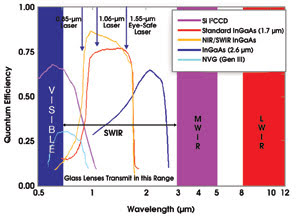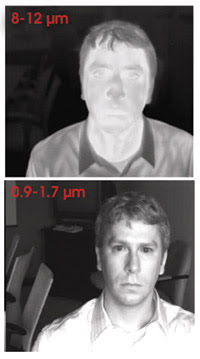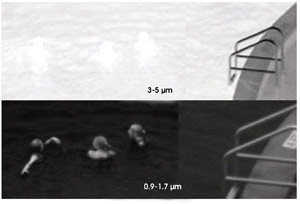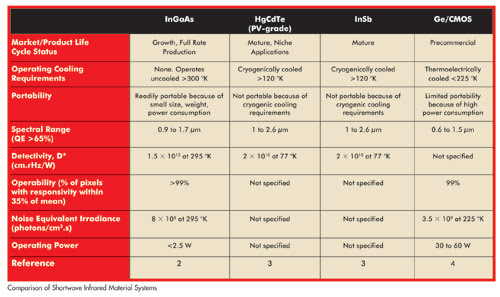InGaAs SWIR imagers get a better look when the heat is on
Dr. David G. Dawes and Devon Turner, Sensors Unlimited Inc.
For military and industrial applications, shortwave infrared (SWIR) has emerged as a key technology, an enabler of a variety of military and industrial imaging and sensing applications. The SWIR band, typically 0.9 to 2.6 μm, and more recently extended down to 0.7 μm, covers most of the void between the intensified silicon imagers and thermal camera spectral ranges of sensitivity. Arguably, the most popular image sensors for the SWIR are made from indium gallium arsenide (InGaAs) photodiode arrays hybridized to CMOS readout integrated circuits.
InGaAs can cover the full SWIR spectrum, bridging the gap from 0.7 μm, where the visible spectrum ends, out to 2.6 μm, where the atmospheric transmission window ends (Figure 1). Substrate-removed, lattice-matched InGaAs optimizes response for the shorter wavelength end of the spectrum, and strained lattice InGaAs extends the cutoff wavelength to 2.6 μm. A highly linear photovoltaic material, InGaAs imaging arrays have steadily been adopted for the most demanding low-light imaging applications because of their superior electrical properties, which are becoming comparable to silicon per unit area.

Figure 1. InGaAs shortwave infrared imagers fill a vital spectral gap between the visible (silicon image-intensified CCD, Gen III night vision goggles) and thermal radiation (3- to 5-μm mid-wave and 8- to 12-μm long-wave infrared) bands.
Sensors Unlimited Inc. of Princeton, N.J., a wholly owned subsidiary of Goodrich Corp., is developing near-quantum-noise-limited, high-sensitivity, large-format InGaAs arrays that can image under starlight-only conditions on the DARPA PCAR program, and extremely compact, lightweight, low-power-consumption SWIR InGaAs imagers for head-mounted and microvehicle applications on the DARPA MISI program.
Key wavelengths detected by SWIR imaging cameras encompass many lasers and sources, including eyesafe wavelengths around 1550 nm used in range detection – those able to transmit greater distances through atmospheric windows while remaining undetectable to most other imaging technologies, including silicon, CCD cameras, night vision tubes and long-wave IR cameras. We have developed a night vision and laser detection camera that can see over an extended spectral region from the near-IR to the SWIR, beyond what traditional night vision goggles can see while retaining backward compatibility to legacy-ranging, night-vision and designating systems. The camera, called NIR/SWIR, uses a proprietary InGaAs night vision technology.
A NIR/SWIR camera can detect and track a broad range of battlefield infrared lasers and identify targets with heightened sensitivity, day or night, supplying enhanced image data not available from other camera technologies. Additionally, SWIR images appear quite similar to visible light-generated images because the photon signal detected in this band comes by reflection from objects in the scene and not directly from their thermal emissions. As a result, SWIR imagery is more intuitive to the human brain and ideal for identifying objects, rather than just detecting their presence or absence (Figure 2).

Figure 2. A SWIR image (bottom) produced by reflected photons appears like a visible image and is more intuitive than a thermal image top).
A SWIR camera can identify objects through moderate mist and haze conditions more accurately than can visible, near-IR and some thermal cameras. In theory, longer wavelengths experience lower scattering and propagate unimpeded through atmospheric haze to produce sharper images of distant objects.
Rayleigh scattering from submicron-size atmospheric particulate suspensions and molecular constituents varies inversely with the fourth power of the wavelength, λ-4, and Mie scattering from larger particles and water droplets is largely wavelength-independent. Although it may seem limited from a theoretical perspective, the reality is a different story, and SWIR often can perform better than longer- wavelength thermal imagers, which suffer in unfavorable scene temperature distributions.
SWIR cameras are particularly effective in producing crisp, detailed imagery during sunrise and sunset, a great challenge for thermal cameras with the accompanying crossover in scene temperatures. In the same manner, thermally uniform scenes such as the swimming pool shown in Figure 3 cannot be rendered in recognizable detail by thermal cameras, whereas a SWIR camera has no trouble producing clear, visiblelike imagery.

Figure 3. In thermally uniform scenes such as a swimming pool, SWIR produces crisp, visiblelike images, whereas thermal imagers fail to show any recognizable detail.
Glass is transparent in the shortwave but not in the mid- or long-wave IR spectral regions. This important advantage enables SWIR images to be acquired through the windows of buildings and vehicles and allows lower-cost glass optics to be used with SWIR cameras.
In the darkest of night scenes, many cameras cannot produce an image because of the lack of available photons. However, a natural phenomenon – nightglow – provides SWIR cameras with a ready light source1. Nightglow illuminates any object not under direct cover and often is strong enough for SWIR cameras to image in the dead of night, even when there is no moonlight.
A host of products
Product offerings from industry for detecting in the SWIR have never been more prevalent. Table 1 compares InGaAs with other material systems that exhibit responsivity in the SWIR band. Besides cryogenic cooling to reduce noise, indium antimonide, a popular material for mid-infrared imagers, requires cold filters to further limit its thermal noise bandwidth. The filters reduce noise but at a cost of lower net responsivity in the SWIR spectral range.
 InSb also exhibits a flashover, or blooming, effect if exposed to visible light that requires temperature cycling from which to recover, whereas InGaAs does not. SWIR-optimized photovoltaic-grade mercury cadmium telluride also requires cryogenic cooling to reduce shot noise from the dark current resulting from higher material defect densities than InGaAs.
InSb also exhibits a flashover, or blooming, effect if exposed to visible light that requires temperature cycling from which to recover, whereas InGaAs does not. SWIR-optimized photovoltaic-grade mercury cadmium telluride also requires cryogenic cooling to reduce shot noise from the dark current resulting from higher material defect densities than InGaAs.
HgCdTe layers grown by molecular beam epitaxy can produce better quality focal plane arrays (FPAs), but the process is very expensive and not suited for volume applications. Both HgCdTe and InSb are not suited for compact, portable applications because of their cryogenic cooling requirements.
Germanium-enhanced CMOS is a new technology offering for the SWIR band that eliminates the FPA to CMOS readout integrated circuits bump bond hybridization process and substitutes a complex custom multilayered hybrid deposition process. In principle, the technology can offer a lower acquisition cost, but the power consumption and size constraints imposed by the need for active cooling severely limit the portability and probability of achieving a low cost from the system.
Typically, InGaAs cameras operate at room temperature or above and offer the highest level of sensitivity and portability and the lowest power consumption. The detector arrays have the highest quantum efficiency in the SWIR, and the very low dark current and noise make the overall cameras noise-limited by the follow-on electronics in every case.
Positive identification has become a critical requirement, as the battlefront has moved into the urban environment in recent years. SWIR imagery, with its more visiblelike quality, is better matched to our brain’s natural pattern recognition cues than counterintuitive thermal imagery. SWIR technology provides day and night imagery that does not require complex or costly postprocessing, combination or fusion with other sensor technologies to be useful.
InGaAs SWIR technology is the best single sensor solution, with the lowest size, weight and power consumption requirements and the most capability for meeting the needs of the global war on terror.
References
1. M. Hansen et al (September 2007). SWIR technology takes surveillance to a new level. Laser Focus World, pp. 80-82.
2. Goodrich Corp., Sensors Unlimited Inc., www.sensorsinc.com.
3. Teledyne Judson Technologies Inc., www.judsontechnologies.com.
4. NoblePeak Vision Corp., www.noblepeak.com.
Meet the authors
David G. Dawes is manager of business development for US Department of Defense applications at Sensors Unlimited Inc. in Princeton, N.J., and Devon Turner, a former applications engineer and defense specialist at the company, is now pursuing an MBA at Northwestern University’s Kellogg School of Management in Evanston, Ill.; e-mail: [email protected]; www.sensorsinc.com.